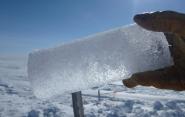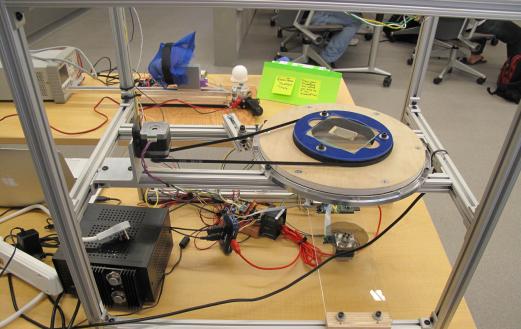The Engineers Who Came In From the Cold

Sipping hot drinks and willing spring to arrive, bundled-up Yalies have recently faced the freezing temperatures of the polar vortex and the blanketing snowfalls of the bombogenesis. But for one team of engineers, below-zero temperatures might have been the perfect new year’s gift.
The reason is ice.
As part of the Mechanical Design class, Levi DeLuke, Maren Hopkins, Dan Rathbone, Jack Rockaway, and Chris Segerblom spent last fall creating a device that could photograph ice core crystals, a project suggested by Larry Wilen, a Yale senior research scientist and design mentor in the Center for Engineering Innovation & Design. Ice cores are among the best records of historic climate conditions, including temperature, precipitation, atmospheric chemistry, volcanic eruptions—even information about the ocean and the sun.
But this data goldmine comes with a catch: it has to be kept cold. Very cold. At the U.S. National Ice Core Laboratory (NICL) in Denver, Col., ice cores are stored at -35 degrees C; when ready for analysis, they are moved into a cold room kept at the comparatively balmy temperature of -22 degrees C.

“Most researchers are in that room for four hours at a time, in and out of -35 and -22, so it’s a lot of time spent in the cold,” says Hopkins, who visited the NICL last fall. “They say the good ones can stay for eight hours, and I was really impressed because I was pretty cold after being in there for maybe an hour.”
In addition to the size and number of ice crystals, a key element of ice core analysis is determining the ice crystals’ grain orientations, which can be used to understand the flow history of the ice. Using a light source and polarizers, the scientists rotate the ice core sample until the desired crystal appears black; this position, known as the “extinction angle,” occurs when the crystal axis is at a specific angle to the viewer, thereby revealing the grain orientation.
The design of the Yale device could potentially improve on the NICL’s current technology with both higher-resolution cameras and more efficient imaging. Using light from an electroluminescent panel, two Raspberry Pi cameras arranged at different angles to the ice surface photograph a thin slice of ice core; the NICL’s current device has only a single lower-resolution camera, producing less defined images and requiring twice as many rotations to capture each possible extinction angle.
The team’s device also incorporates at least one low-tech—albeit significant—improvement. To combat the cold, ice core scientists wear what Hopkins describes as “giant coveralls, multiple hats, gloves, and boots that make you trip all over the place”—clothing that makes using the small components of the current NICL device difficult unless the scientists take off their gloves. As such, the Yale team strategically used larger components and even wore thick gloves during their testing to ensure the scientists’ comfort. “However, we didn’t have a full-size cold room where we could test everything—so that’s for future steps,” says Segerblom.
Perhaps this week is the perfect time for a little more testing in the field—while wearing gloves, of course.

